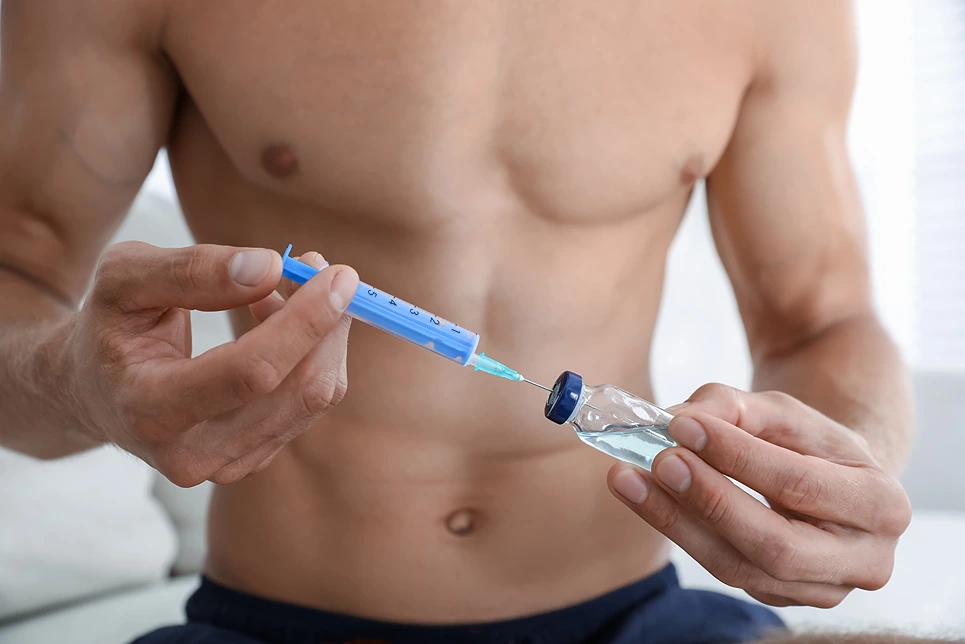Let’s dive into the fascinating world of how injectable testosterone works its magic after those injections!
Once you inject testosterone, the action starts immediately with the help of two powerful enzymes that kickstart a chain of events.
These two enzymes are esterases and hydrolyze. They play a crucial role in breaking down the ester and activating the hormone. Not many people are aware of this process, but trust me, it’s pretty cool stuff.
Now, let’s talk about the Esters Active Half-Life Table. This table explains that hormone treatment is not a one-size-fits-all solution. There are different types of enzymes involved in the cleaving process of the ester, which activate the hormone.
Esterases and hydrolysates
swoop in and cleave pieces of the ester off the hormone, releasing the active chemical. This allows the hormone to work its magic, promoting muscle building, tissue growth, and other awesome benefits.
In the bloodstream, where testosterone and other essential nutrients circulate, these enzymes play a crucial role. They directly impact the release of active hormones by breaking down the ester, leading to different effects in different individuals.
So, next time you get that testosterone injection, remember the amazing work these enzymes are doing behind the scenes. It’s like a secret superhero mission happening inside your body!
Esters are the spice that adds flavor to the chemical world. They come in a variety of shapes and sizes, giving compounds their own unique flair. But determining how long these compounds linger in our bodies can get a bit hazy.
There’s a plethora of conflicting information about the half-life of different compounds. Some sources don’t even bother to cite their sources! It’s like trying to navigate a maze blindfolded.
Fear not, for I am here to illuminate the subject. When it comes to esters, I’m solely focused on the terminal half-life – the time it takes for a substance to lose half of its activity. Think of it as the chemical equivalent of hitting the snooze button.
Unlocking the Mystery: How Long Do Steroid Esters Last?
So, if you’re curious about how long your favorite compound will be sticking around, look no further. We’ve got all the juicy details on terminal half-life right here. Let’s dive in and unravel the mysteries of esters together!
Just a friendly reminder: these half-lives are estimates and may vary slightly based on injection site, carrier oil, and other factors. Unfortunately, there haven’t been many pharmacokinetic studies conducted on the majority of AAS. So, most of what we know about half-lives is just theoretical mumbo jumbo until we get some real data.
Let’s dive into the world of esters – the fancy stuff that can make or break your gains!
When you inject an anabolic steroid, the sneaky ester attached to it plays a crucial role. It contributes to the total molecular weight of the molecule, which means you might not be getting as much pure testosterone as you initially thought. As a result, the actual dose of active testosterone is lower than it appears on the label. This is because the ester acts like a ninja, silently hiding the true amount of testosterone. However, once the steroid enters your body, the esterase enzyme comes into play. Eventually, it breaks the bond and releases the active testosterone. Therefore, understanding the role of esters is essential for accurately gauging dosage and effects.
Long-chain esters like Cypionate, Decanoate, and Enanthate are the heavyweights in the molecular world. This means that on a milligram-for-milligram basis, you’re getting more bang for your buck with short-estered compounds. For example, there’s more testosterone in 100mg of Testosterone Propionate than in 100mg of Testosterone Enanthate. Why? Because the Propionate ester is as light as a feather compared to the Enanthate ester, which is as heavy as a brick!
So, when you’re planning your cycle, don’t forget to consider the weight of those esters. It’s a small detail that can have a big impact on your gains.
And let’s not forget about the half-life of these esters. It determines how long they stay active in your body, with the terminal half-life telling you when the concentration of the ester decreases by half. It’s like a countdown to when you need to inject again to keep those gains coming.
Here is a breakdown of the half-life and terminal half-life of different esters commonly found in anabolic steroids:
– Acetate: Half-life of 3 days, terminal half-life of 1 day
– Propionate: Half-life of 2 days, terminal half-life of 0.8 days
– Phenylpropionate: Half-life of 4.5 days, terminal half-life of 1.5 days
– Butyrate: Half-life of 2-3 days
– Valerate: Half-life of 3 days
– Hexanoate: Half-life of 3 days
– Caproate: Half-life of 4-5 days
– Isocaproate: Half-life of 9 days, terminal half-life of 4 days
– Heptanoate: Half-life of 5-6 days
– Enanthate: Half-life of 10.5 days, terminal half-life of 4.5 days
– Cypionate: Half-life of 6-7 days, terminal half-life of 5 days
– Octanoate: Half-life of 6-7 days
– Nonanoate: Half-life of 7 days
– Decanoate: Half-life of 15 days, terminal half-life of 7.5 days
– Undecylenate: Half-life of 8-9 days, terminal half-life of 14 days
– Undecanoate: Half-life of 16.5 days, terminal half-life of 20.9 days
The following table displays the percentages of the actual hormones for each ester:
Ester% % Of The Actual Hormone
Acetate 87%
Propionate 80%
Phenylpropionate 66-67%
Isocaproate 72%
Enanthate 70%
Cypionate 69%
Decanoate 62%
Undecylenate 61%
Undecanoate 61%
These percentages indicate the concentration of the hormone in each ester. It is crucial to take these values into account when choosing the right ester for a particular use.
Knowing the half-life and terminal half-life of these esters is essential for figuring out the frequency and timing of anabolic steroid cycles.
We trust you found this information enlightening and helpful!
Best regards,
Team EP

